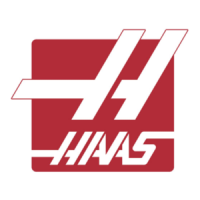20. With Z-axis pitch established, repeat all steps to verify X-axis roll (and pitch, if the machine has the
means for such an adjustment), Z-axis pitch and roll, and the indication in the Z-axis across the platter
of table. If all are correct, move on to A-axis rotation, geometry, and TC alignment verification. If not
correct, repeat the necessary steps to correct the error.
21. If the machine is to be anchored, perfect level must first be achieved. After the anchors are locked in,
and 80 ft/lbs of torque applied, Step 20 must be repeated.
22. When leveling is complete, reinstall Z-axis waycovers and seal with black RTV.
NOTE: Once these steps are verified to be correct, with the axes at the center of travel
and the bubble level at the center of the table checking in the X and Z plane,
it is possible that the machine table surface may not be perfectly perpendicular
to earth gravity. This is acceptable, as long as the machine is square and its
geometry is correct.
NOTE: If the Z-axis pitch cannot be adjusted to an acceptable tolerance that allows
for correct geometry; it will be necessary to determine the cause for error in the
Z-axis flatness, and to take the necessary steps to correct the problem.
Normally this is due to a bow in the casting between the front and the rear of
the Z-axis portion of the base casting, and adjusting leveling screws 5 and 6
will correct this. If the pitch cannot be adjusted into tolerance with leveling
screws 5 and 6, it may be that an upward bow is present. If so, it may be
necessary to anchor the machine to bring the flatness into specification. If you
believe this condition exists, please contact Haas factory service.
A-axis Rotation Verification
These steps measure the parallelism of the A-axis (axis of rotation) to the Y-axis, and the platter face runout.
The EC-1600 geometric inspection report (GIR) is placed in the back of the operator's manual when the ma-
chine is shipped from the factory. Refer to this document for A-axis and column square verification.
1. To check the axis of rotation, check a single point at four positons, 90° apart on a 1-2-3 block, as
shown in the illustration. Rotate the platter 90° CW, then jog the X and Z axes to the indicating point.
Check the block in the same spot, record the reading, and repeat the procedure every 90°.
If the A-axis is an indexing axis, (not a full 4th rotary axis) remove the 1-2-3 block while indexing
between readings to provide clearance for platter pop-up.
NOTE: The readings are not to exceed 0.0005".
2. To check the platter face runout, check four points,
90° apart, by indicating the runout at the 0° position
(as shown in the previous illustration). To do this, jog
the axis to locate the indicator at the 0° position
and zero out the indicator. Leave the indicator in this
position for all four readings. Rotate the platter at
90° increments and record the readings.
NOTE: The readings are not to exceed 0.002".
Geometry Verification
These steps measure the squareness of the Y-axis to the X-
axis, and the squareness of the Y-axis to the Z-axis.
"Y" Axis
"Z" Axis
"X" Axis
Gage Block
Platter
"A" Axis
2
3
4
1
© Copyright 2015 by Haas Automation, Inc. No unauthorized reproduction.

